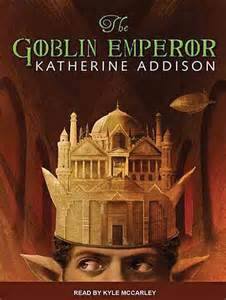Book Review by Kerey McKenna
 A strong showing from first time author Katherine Addison, The Goblin Emperor is an enthralling tale of court intrigue set inside the royal palace of an Elven Steampunk Empire (or perhaps more accurately, a Dungeon/Magic-Punk Empire).
A strong showing from first time author Katherine Addison, The Goblin Emperor is an enthralling tale of court intrigue set inside the royal palace of an Elven Steampunk Empire (or perhaps more accurately, a Dungeon/Magic-Punk Empire).
In the long history of the empire of the Elflands, Maia was destined to be but a footnote of a footnote. The product of a political union between the pale elven emperor and a dusky skinned goblin princess, Maia was unneeded and unwanted in his father’s plans for imperial dynasty. Having already sired three sons of pure elven blood from previous marriages, the emperor banished his goblin consort and her son Maia to an isolated country estate, overseen by the emperor’s estranged—and abusive—cousin, to be kept out of sight and out of mind. Losing his mother at the age of eight, Maia, of royal blood but not recognized as a prince of the realm, expected only to spend the rest of his days in quiet, if barely tolerable exile.
However, despite the weight of time and history, the course of dynasties can change very quickly—as Maia learns. He is summoned to court, just shy of his 18th birthday, because his emperor father and the recognized princes of the realm have died in an airship crash (airships, pocket watches, and the occasional mention of steam power being the novel’s sometimes hesitant steps out of fantasy and into the steam/dungeon punk genre). Now Maia, having never even attended court, must not only navigate the Byzantine etiquette and politics of the royal palace, but also preside over them as emperor. That is, if the conspiracy that brought down the emperor’s airship doesn’t rob him of his crown (or his head!), bringing a quick end to his reign and relegating the Goblin Emperor once again to the footnotes of history.
At its core is a premise like many “king for a day” tales, such as The Prince & the Pauper or in modern times, Kevin Kline’s accidental ascent to the U.S. Presidency in the film Dave. But just as some have said that Downton Abby is a rather standard soap opera but with posh accents and decadent set dressing, sometimes the setting does make the drama. Katherine Addison erects a mighty palace around the protagonist and reader and both are kept bewildered by the complex politics of palace life, made all the more alien by use of fantastical names and created languages and rituals. While magic and mechanics are understood to play a part in this world, Addison keeps a tight focus on the rituals of court and the intricacies of social etiquette. Addison also goes on to eschew fantasy’s Eurocentric tendencies and seems to model certain aesthetics from the Eastern Roman Empire (Constantinople), the Middle East, and the far Orient, which for a Westerner such as myself added to the enthralling, yet alienating royal court as opposed to feeling like just another day at the Ren Fair. I often was reminded of the 1987 film The Last Emperor and its lavish reconstruction of China’s Forbidden City. The book also takes a nice rabbit punch at a fantasy convention that has irked me for some time: the clichés of the fair and beautiful elves and the ugly and evil Orcs, Goblins, and Ogres. The goblins are a minority within the Elflands; with their curly hair and dark skin, the parallel to real-life people of color is clear. While some of the blue blood elves may look upon the goblins with disdain, the readers are not asked to accept the paradigm and we are introduced to elves and goblins of all shapes, sizes, attractiveness, and virtue.
A further word on the use of steampunk or dungeon-punk elements: While I would not recommend this book as an introduction to either genre, I would gladly cite it as an example of how to use these genres subtly. The author did not feel the need to slap goggles and waistcoats on every character or beat the reader over the head with magic-powered technology. Despite the presence of airships, we understand that this is a world on its first steps into an industrial age and I found the implication that there is technology and industry in this world, but the royal court sees very little of it, to build into the themes of isolation and stagnation of the royal court. Again thinking of The Last Emperor, we are presented with the possibility that as the aristocracy concerns itself with age-old rituals and ceremonies, technological innovations and societal revolutions may soon topple the whole system.
I found myself charmed by this novel and would recommend it to old fans of the fantasy genre as well as those fans of historical fiction and tales of court intrigue who tend to stay away from “high fantasy” because of the genre’s perceived obsession with epic battles and long sagas. It is a self-contained novel, but I hope Ms. Addison will return to this world soon: she has planted some intriguing seeds for future stories.
Kerey McKenna is a contributing reviewer to Nerds who Read and SMOF for the annual Watch City Steampunk Festival, coming to Waltham, Massachusetts on May 7, 2016. Learn more at www.watchcityfestival.com.

No comments:
Post a Comment